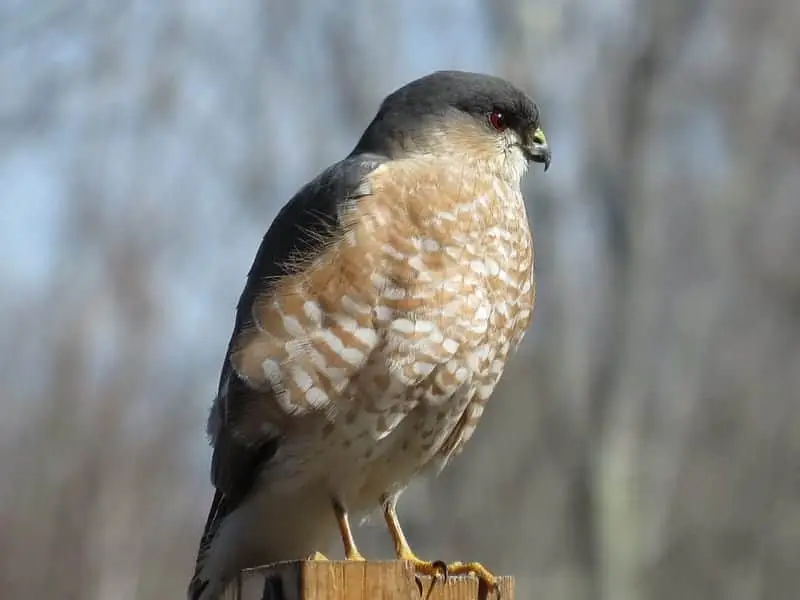
Want to learn more? This book on the Birds of Prey of North America is a fantastic read!
Tennessee is a state in the Southern United States known for its iconic arts and entertainment scene.
However, this landlocked state offers a dynamic home to wildlife. Tennessee is recognized for its moderate climate, featuring its four distinct seasons with cool, mild winters, and warm summers.
The distinctive seasons make the state perfect for its wonderfully inviting recreational opportunities offered by its 56 state parks.
These parks are home to a wealth of diverse birdlife year-round, particularly, Big Hill Pond State Park. A fascinating nine species of hawk can be discovered within the state of Tennessee.
You are most likely to spot the Red-tailed Hawk, while you are least likely to observe the Northern Goshawk.
This dynamic southern state allows for exceptional opportunities to discover several species of hawks.
Below you’ll find a distinctive profile for each of these hawks, including their comprehensive descriptions and the ideal locations to sneak a peek of these species in their natural habitat.
You will gain quite a bit of knowledge about these species of hawks, read on to learn more about the robust characteristics of each species!
Want to attract birds of prey to your yard? Take a look at our article!
What Hawks can be seen in Tennessee?
Table of Contents
1. Sharp-Shinned Hawk

“Sharp-Shinned Hawk” by ‘Dennis Murhpy‘ is licensed under CC BY 2.0
Wingspan
43-56cm
Weight
87-218g
Life Expectancy
3 years
Diet
Robins and Thrushes
The Sharp-Shinned Hawk is a particularly small species of hawk.
In fact, male Sharp-Shinned Hawks are known to be the smallest hawks in the United States. However, the females within this species are nearly one-third larger than males.
The Sharp-Shinned Hawk has gray-colored feathers with a pale orange barring below its breast.
Young Sharp-Shinned Hawks are more of a brown color, noted to have white feathers underneath.
With an increasing population, Sharp-Shinned Hawks are now classified as being of least concern with regard to conservation status.
These hawks tend to breed in extensive forests, taking habitat in dense trees, well hidden between 20-60 feet off the ground making its nest from large twigs.
Fascinatingly, the Sharp-Shinned Hawk is recognized by its two distinct calls, one being a frantic, repetitive ‘kik-kik’ sound, and the other being a high-pitched squeal.
Sharp-Shinned Hawks are most common in eastern Tennessee during autumn migration in September and October and can be spotted along the eastern mountains.
2. Cooper’s Hawk

Wingspan
62-90cm
Weight
330-680g
Life Expectancy
Up to 12 years
Diet
Small Birds, Mice & Squirrels
Cooper’s Hawks are medium in size with females being larger and heavier than the males.
They are noted as having round wings and a round tail. Adult hawks have steel blue colored feathers on their backs and wings, with an underbelly that is adorned with warm red feathers.
In contrast, young hawks have brown feathers on their backs and wings, with streaks of brown covering underneath.
This ever-increasing population of hawks typically live in forests, open woodlands, woodlots, and forested mountainous regions.
They build their nests in crotches or horizontal branches of trees and are known to be highly territorial.
Cooper’s Hawks tend to be quieter during the breeding season in early March and is not the ideal time to spot one.
The hawks can ideally be observed soaring through the air during migration, generally beginning in late August through early November.
3. Northern Goshawk

Wingspan
89-127cm
Weight
631-1364g
Life Expectancy
7 Years
Diet
Mammals, reptiles & insects
Northern Goshawks are a medium-large species of hawk.
The mature Goshawks are grey with pastel grey underneath, while the young Goshawks usually have streaky brown feathers.
Similar to other species of hawks, male Goshawks are smaller and less heavy than their female counterparts. Goshawks have a rapid call that favors a ‘ki-ki-ki’ sound.
They can be seen nesting in forests, in cone-bearing trees. Take note, these hawks tend to be defensive when it comes to their territories, so it’s safest to admire them from afar.
The breeding period for Goshawks lasts from April to June, and the ideal time to see a Northern Goshawk is during the spring and autumn months before winter migration.
They can often be observed in trees in a mixed forest area near a major crotch in the trunk. Goshawks’ nests can be identified by distinctive green foliage.
4. Red-Shouldered Hawk

Wingspan
94-111cm
Weight
486g-774g
Life Expectancy
2 years
Diet
Small mammals, reptiles & amphibians
The Red-Shouldered Hawk is a large species of hawk, recognized by its long tail and the vibrant colors of its feathers.
The adult hawks have various color patterns with their white and dark brown patterned wings with rich warm orange feathers on its underbelly.
Young hawks however, can be distinguished by their brown backs and white underneath. Red-Shouldered Hawks primarily nest in deciduous forests, building their nests in the trunk of trees near open waters or swamps.
The Red-Shouldered Hawk’s call is a repetitive ‘kee-aah’ sound with the first note being high pitched, and the second note being lower in pitch.
The best chance to see a Red-Shouldered Hawk is during the autumn months during migration, as they are observed soaring, gliding, and flapping at high altitudes.
They can also be spotted in forested areas, perched and ready for their prey.
5. Broad-Winged Hawk

“Broad Winged Hawk” by ‘Felipe Uribe‘ is licensed under CC BY 2.0
Wingspan
81-100cm
Weight
265g-560g
Life Expectancy
Up to 20 years
Diet
Small mammals & insects
Broad-Winged Hawks are medium in size with reddish-brown feathers and distinctive black and white bars on their tails.
You may note the difference that younger Broad-Wings, however, have light brown feathers.
It’s most common for this species of hawk to nest in forests, often with water or wetlands nearby.
Broad-Wings are known for their high-pitched whistles with a short first note and a long second note, most often heard during the summer months.
Interestingly, the male Broad-Wings call is an octave higher than the female’s.
A Broad-Wing’s migration can be seen during mid-September and early October in eastern Tennessee near Chattanooga.
Though these hawks are common in eastern Tennessee, they are rarely seen in the western areas.
6. Swainson’s Hawk

Wingspan
4 feet
Weight
693-1367g
Life Expectancy
16-19 years
Diet
Mammals & Insects
Swainson’s Hawks are large hawks with short tails and broad wings with typically dark-colored feathers and bright white underparts.
However, there can be a slight variation of color with these particular hawks. Swainson’s Hawks have a shrill, piercing alarm call, often responding to intruders.
Female hawks usually give a shorter, lower-pitched version of the call. Most Swainson’s Hawks tend to migrate during the autumn, around late August.
These hawks tend to spend their time in open areas while they build their homes in grasslands. They are usually spotted perched on high places to gain a view of open grasslands.
They use this open space to hunt for their prey. The best time to see a Swainson’s Hawk can be seen in the trees of Tennessee during the summer and as they return from migration in the spring.
7. Red-Tailed Hawk

Wingspan
114-133cm
Weight
900-1460g
Life Expectancy
10-15 years
Diet
Small mammals, mice & voles
The Red-Tailed Hawk is recognized as the second-largest hawk, and one of the most common, in North America.
These hawks definitely live up to their name as indicated by their red tails with pale feathers underneath.
Immature Red-Tailed Hawks, however, do not have red tails. Mature Red-tailed Hawks are identified by their hoarse ‘kee-eeeee-arr’ sounding call.
During mating season, however, they are known to make a shrill cry. Additionally, during mating season, male Red-Tails will circle at extensive heights to attract females.
These hawks tend to be recluse, and are commonly seen in open fields or resting in tall trees observing their landscape for prey.
The optimum place to observe a Red-Tailed Hawk is in open areas in large trees, where they tend to nest during the summer months.
Their homes can be identified by plentiful materials that are added to the nest each year, sometimes reaching over three feet in diameter.
8. Rough-Legged Hawk

Wingspan
132-138cm
Weight
715-1400g
Life Expectancy
Up to 18 years
Diet
Small rodents
Rough-Legged Hawks are classified as medium to large sized birds with their distinguishing unique feather patterns.
These hawks are recognized for their light-colored, pastel heads and dark underbellies.
They also have light-colored tails with darker feathers on the tip of the tail. Rough-Legged Hawks can be observed awaiting its prey over open areas such as fields, which are highly common throughout the state of Tennessee.
These particular hawks are identified by their catlike cries and their hiss like whistles.
Their nests are built with a bulky mass of sticks on the cliff sides. During breeding season, the Rough-Legged hawks circle together high in the air, flapping to high elevation and then diving steeply.
These hawks tend to breed in the arctic and migrate in winter. The Rough-legged Hawk is rare to spot in some cooler parts of Tennessee, but are prominent during the summer months.
The best place to search for the Rough-Legged Hawk in Tennessee is an open country area on a narrow ledge or high cliff, or at the top of a tree.
9. Northern Harrier

Wingspan
120cm
Weight
390g
Life Expectancy
16 years
Diet
Rodents and small birds
Northern Harrier Hawks are medium-sized hawks with long tails and thin, broad wings.
This species of hawk slightly resembles an owl, though they bear no relation. Female and juvenile Northern Harriers are warm brown while adult males are gray above with white underbellies, and black wingtips.
Northern Harriers give a rapid series of ‘kek’ sounds most often heard when threatened by predators. Female Northern Harriers are known to give a high pitched whistle.
Northern Harriers prefer wetlands or grasslands, and commonly nest on the ground in dense fields, marsh, or even over shallow waters.
Northern Harriers are commonly seen during the winter months sometimes present from August to May easily spotted by observers.

More Articles.

What does it mean to see a Hummingbird?
The hummingbird is easily one of the most celebrated birds in any area. Be it

Can you keep a Hummingbird as a Pet in the US?
In the US, it is in fact illegal to keep hummingbirds as pets in your

Birds are known to come in many different colors. Even birds of a similar species

About Us
We are avid bird-watchers who recently retired, allowing us more time to travel the world. Fortunately, we have managed to visit numerous countries around Europe, Asia, and America. Watching and photographing birds has been a passion for many years and we are making the most of the extra time on our hands!
